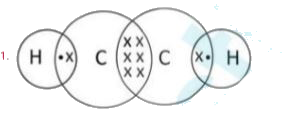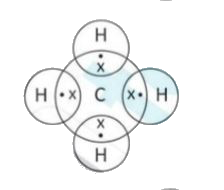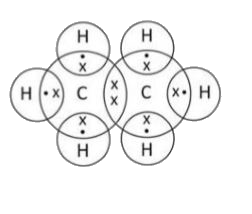discuss the orbital structure of ethene
To discuss the orbital structure of ethene (C2H4), we need to analyze the atomic orbitals involved in its bonding. Here’s a step-by-step breakdown of the orbital structure of ethene:
Step 1: Determine the Molecular Formula
Ethene has the molecular formula C2H4, indicating that it consists of two carbon atoms and four hydrogen atoms.
Hint: Remember that the molecular formula provides insight into the number of atoms and their types in the molecule.
Step 2: Understand the Electron Configuration of Carbon
The electron configuration of a carbon atom is 1s² 2s² 2p². This means that in its ground state, carbon has two electrons in the 1s orbital, two in the 2s orbital, and two in the 2p orbitals.
Hint: The valence electrons (2s² 2p²) are crucial for bonding and hybridization.
Step 3: Excited State Configuration
To form bonds, carbon can promote one of its 2s electrons to the 2p orbital, resulting in an excited state configuration of 1s² 2s¹ 2p³. This configuration allows carbon to have four unpaired electrons.
Hint: Excited state configurations are important for understanding how atoms can bond and form hybrid orbitals.
Step 4: Hybridization
In ethene, carbon undergoes sp² hybridization. This means that one 2s orbital and two 2p orbitals mix to form three equivalent sp² hybrid orbitals. The remaining 2p orbital remains unhybridized.
Hint: Hybridization helps explain the geometry of the molecule and the types of bonds formed.
Step 5: Bond Formation
Each carbon atom uses its three sp² hybrid orbitals to form sigma (σ) bonds:
- Two sp² hybrid orbitals from each carbon overlap with the 1s orbitals of two hydrogen atoms to form two C-H σ bonds.
- The third sp² hybrid orbital from each carbon overlaps with the other carbon's sp² hybrid orbital to form a C-C σ bond.
Hint: Sigma bonds are formed by head-on overlapping of orbitals, which allows for free rotation around the bond axis.
Step 6: Pi Bond Formation
The unhybridized 2p orbitals on each carbon atom overlap sidewise to form a pi (π) bond. This π bond is what gives ethene its characteristic double bond.
Hint: Pi bonds restrict rotation around the bond axis, contributing to the rigidity of the double bond.
Step 7: Orbital Structure Visualization
The orbital structure of ethene can be visualized as:
- Each carbon atom has three sp² hybrid orbitals forming σ bonds with hydrogen and the other carbon.
- The unhybridized p orbitals on each carbon overlap to form the π bond.
Hint: Visualizing the orbital structure helps in understanding the geometry and bonding in the molecule.
Conclusion
In summary, the orbital structure of ethene involves sp² hybridization of carbon atoms, resulting in the formation of σ and π bonds, which contribute to the molecule's double bond character.
---
Ethene has the molecular formula C2H4, indicating that it consists of two carbon atoms and four hydrogen atoms.
The electron configuration of a carbon atom is 1s² 2s² 2p². This means that in its ground state, carbon has two electrons in the 1s orbital, two in the 2s orbital, and two in the 2p orbitals.
To form bonds, carbon can promote one of its 2s electrons to the 2p orbital, resulting in an excited state configuration of 1s² 2s¹ 2p³. This configuration allows carbon to have four unpaired electrons.
In ethene, carbon undergoes sp² hybridization. This means that one 2s orbital and two 2p orbitals mix to form three equivalent sp² hybrid orbitals. The remaining 2p orbital remains unhybridized.
Each carbon atom uses its three sp² hybrid orbitals to form sigma (σ) bonds:
- Two sp² hybrid orbitals from each carbon overlap with the 1s orbitals of two hydrogen atoms to form two C-H σ bonds.
- The third sp² hybrid orbital from each carbon overlaps with the other carbon's sp² hybrid orbital to form a C-C σ bond.
The unhybridized 2p orbitals on each carbon atom overlap sidewise to form a pi (π) bond. This π bond is what gives ethene its characteristic double bond.
The orbital structure of ethene can be visualized as:
- Each carbon atom has three sp² hybrid orbitals forming σ bonds with hydrogen and the other carbon.
- The unhybridized p orbitals on each carbon overlap to form the π bond.
In summary, the orbital structure of ethene involves sp² hybridization of carbon atoms, resulting in the formation of σ and π bonds, which contribute to the molecule's double bond character.
Topper's Solved these Questions
- ORGANIC CHEMISTRY: SOME BASIC PRINCIPLES AND TECHNIQUESBOOK - CBSE COMPLEMENTARY MATERIALCHAPTER - ORGANIC CHEMISTRY: SOME BASIC PRINCIPLES AND TECHNIQUESEXERCISE - 3 mark questions
5 Videos
- ORGANIC CHEMISTRY: SOME BASIC PRINCIPLES AND TECHNIQUESBOOK - CBSE COMPLEMENTARY MATERIALCHAPTER - ORGANIC CHEMISTRY: SOME BASIC PRINCIPLES AND TECHNIQUESEXERCISE - 5 mark questions
15 Videos
- ORGANIC CHEMISTRY: SOME BASIC PRINCIPLES AND TECHNIQUESBOOK - CBSE COMPLEMENTARY MATERIALCHAPTER - ORGANIC CHEMISTRY: SOME BASIC PRINCIPLES AND TECHNIQUESEXERCISE - 2-marks quetion
26 Videos
- HYDROGENBOOK - CBSE COMPLEMENTARY MATERIALCHAPTER - HYDROGENEXERCISE - Unit Test
11 Videos
- P-BLOCK ELEMENTSBOOK - CBSE COMPLEMENTARY MATERIALCHAPTER - P-BLOCK ELEMENTSEXERCISE - UNIT TEST
8 Videos
Similar Questions
Knowledge Check
The electronic dot and cross structure of ethene is _____.
A B
B C
C D
D
Discuss the histological structure of striated muscle.
View SolutionDiscuss the structure of benzene in terms of resonance and orbital concept.
View SolutionDiscuss the structure of benzene with an emphasis on resonance and orbital pictures.
View SolutionDiscuss the structure of human ear from auditory aspect only.
View SolutionDiscuss the structure of maize grain.
View SolutionWhat are proteins ? Discuss briefly the structure of proteins .
View SolutionDiscuss the structure of beryllium chloride in different states.
View Solution
